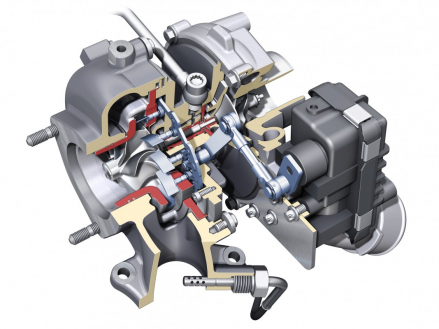Turbochargers with variable turbine geometry (VTG)
In all TDI engines from Audi, the turbochargers have variable turbine geometry on the exhaust side. Variable turbine geometry (VTG) technology builds up torque smoothly and without delay, even at low engine speeds.
If the driver presses the gas pedal down firmly at a low engine speed, the turbine blades move to a steep angle. This reduces the cross section of the inlet to the turbine housing and channels the exhaust gas directly to the blades. The turbine wheel rotates faster, the volume of fresh air delivered by the turbocharger increases and boost pressure builds up instantly.
As the volume of exhaust gas increases, or if less boost pressure is required, the turbine blades return to a flatter angle. The cross section of the inlet increases, and a portion of the exhaust gas flows past the turbine rotor. The turbine turns more slowly, and boost pressure is reduced. This effect is particularly important when the turbocharger has to push through large exhaust flows at high engine loads and speeds. Without VTG technology, the useful speed range would be limited, and the engine would be less efficient.
Status: 2011
